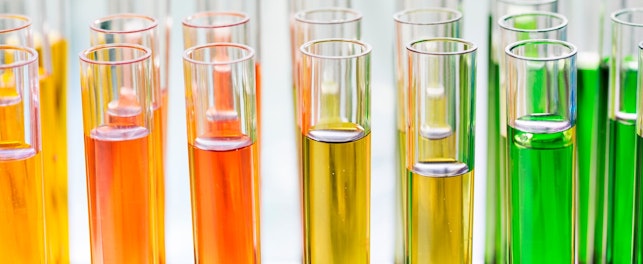On January 17, 2022, the ECHA added four new SVHCs to the Candidate List. The addition of these new SVHCs brings the total number of entries to 223.
On January 17, 2022, the European Chemical Agency (ECHA) added four new SVHCs to the Candidate List [1]. The addition of the new SVHCs brings the total number of entries to 223.
The four new SVHCs are:
- 6,6'-Di-tert-butyl-2,2'-methylenedi-p-cresol (DBMC)
- Tris(2-methoxyethoxy)vinylsilane
- Hydrolyses rapidly when in contact with water or air moisture to release 2-methoxyethanol, which is also a SVHC on the Candidate list added in 2010
- (±)-1,7,7-Trimethyl-3-[(4-methylphenyl)methylene]bicyclo[2.2.1]heptan-2-one covering any of the individual isomers and/or combinations thereof (4-methylbenzylidene camphor, 4-MBC)
- S-(Tricyclo[5.2.1.0'2,6]deca-3-en-8(or 9)-yl) O-(isopropyl or isobutyl or 2-ethylhexyl) O-(isopropyl or isobutyl or 2-ethylhexyl) phosphorodithioate
In addition, an earlier group entry on the SVHC Candidate List is also revised. The group entry “Nonadecafluorodecanoic acid (PFDA) and its sodium and ammonium salts” previously included two entries: “Decanoic acid, nonadecafluoro-, sodium salt” and “sodium nonadecafluorodecanoate.” As these two names describe the same substance and are equivalent, “Decanoic acid, nonadecafluoro-, sodium salt” was removed from the list. This amendment does not affect the number of entries in the SVHC Candidate List.
Obligations for article producers and importers
According to Article 33 of REACH, European Union (EU) and European Economic Area (EEA) manufacturers and importers of articles are required to provide information to allow the safe use of products by the recipients upon supply, and to consumers within 45 days upon request, when the concentration of the SVHC in the article exceeds 0.1% (w/w). For articles that contain an SVHC in which the concentration is above 0.1%, with the quantity over one tonne per year, a notification shall be submitted to ECHA by the manufacturers or the importers under Article 7 of REACH. The notification of SVHCs in an article must be made within six months of their inclusion on the List. The notification deadline for the four new SVHCs added to the Candidate List is July 17, 2022.
As of January 5, 2021, EU producers, importers, assemblers and distributers of articles containing above 0.1% w/w of a SVHC on the Candidate List shall submit a notification to the Substances of Concern in articles as such or in complex objects (Products) (SCIP) database under the Waste Framework Directive (WFD).
The potential uses of these new SVHC candidates are summarized in Table 1.
No. | Substance | CAS No./ EC No/ | Classification | Potential Uses |
|---|---|---|---|---|
| 1 | 6,6'-Di-tert-butyl-2,2'-methylenedi-p-cresol (DBMC) | 119-47-1 / 204-327-1 | Repr. 1B |
|
| 2 | Tris(2-methoxyethoxy)vinylsilane | 1067-53-4/ 213-934-0 | Repr. 1B |
|
| 3 | (±)-1,7,7-Trimethyl-3-[(4-methylphenyl)methylene]bicyclo[2.2.1]heptan-2-one covering any of the individual isomers and/or combinations thereof (4-MBC) | - / - | ED |
|
| 4 | S-(Tricyclo[5.2.1.0'2,6]deca-3-en-8(or 9)-yl) O-(isopropyl or isobutyl or 2-ethylhexyl) O-(isopropyl or isobutyl or 2-ethylhexyl) phosphorodithioate | 255881-94-8/ 401-850-9 | PBT |
|
Table 1. Possible uses of the new SVHCs in the Candidate List published by ECHA on January 17, 2022
Abbreviations
- ED: Endocrine disrupting
- PBT: Persistent, bioaccumulative and toxic
- Repr. 1B: Toxic to reproduction category 1B
SGS is committed to providing information about development in regulations for consumer products as complimentary services. Through a global network of laboratories, SGS provides a wide range of services including physical/mechanical testing, analytical testing and consultancy work for technical and non-technical parameters applicable to a comprehensive range of consumer products. In the end, it’s only trusted because it’s tested. Contact us for more information or visit our website.
For inquiries, please contact:
Emily Lam
R&D Manager
t: +852 2204 8339
© SGS Group Management SA - 2022 - All rights reserved - SGS is a registered trademark of SGS Group Management SA. This is a publication of SGS, except for 3rd parties’ contents submitted or licensed for use by SGS. SGS neither endorses nor disapproves said 3rd parties contents. This publication is intended to provide technical information and shall not be considered an exhaustive treatment of any subject treated. It is strictly educational and does not replace any legal requirements or applicable regulations. It is not intended to constitute consulting or professional advice. The information contained herein is provided “as is” and SGS does not warrant that it will be error-free or will meet any particular criteria of performance or quality. Do not quote or refer any information herein without SGS’s prior written consent.



